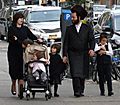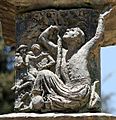Hasidic Judaism facts for kids
| Part of a series on | |||
|---|---|---|---|
|
|||
| Judaism | |||
| Category | |||
| Jewish religious movements | |||
| Orthodox (Haredi • Hasidic • Modern) | |||
| Conservative • Reform | |||
| Reconstructionist • Renewal • Humanistic | |||
| Jewish philosophy | |||
| Principles of faith • Kabbalah • Messiah • Ethics | |||
| Chosenness • Names of God • Musar | |||
| Religious texts | |||
| Tanakh (Torah • Nevi'im • Ketuvim) | |||
| Ḥumash • Siddur • Piyutim • Zohar | |||
| Rabbinic literature (Talmud • Midrash • Tosefta) | |||
| Religious Law | |||
| Mishneh Torah • Tur | |||
| Shulchan Aruch • Mishnah Berurah | |||
| Kashrut • Tzniut • Tzedakah • Niddah • Noahide laws | |||
| Holy cities | |||
| Jerusalem • Safed • Hebron • Tiberias | |||
| Important figures | |||
| Abraham • Isaac • Jacob | |||
| Moses • Aaron • David • Solomon | |||
| Sarah • Rebecca • Rachel • Leah | |||
| Rabbinic sages | |||
| Jewish life cycle | |||
| Brit • Pidyon haben • Bar/Bat Mitzvah | |||
| Marriage • Bereavement | |||
| Religious roles | |||
| Rabbi • Rebbe • Posek • Hazzan/Cantor | |||
| Dayan • Rosh yeshiva • Mohel • Kohen/Priest | |||
| Religious buildings & institutions | |||
| Synagogue • Beth midrash • Mikveh | |||
| Sukkah • Chevra kadisha | |||
| Holy Temple / Tabernacle | |||
| Jewish education | |||
| Yeshiva • Kollel • Cheder | |||
| Religious articles | |||
| Sefer Torah • Tallit • Tefillin • Tzitzit • Kippah | |||
| Mezuzah • Hanukiah/Menorah • Shofar | |||
| 4 Species • Kittel • Gartel | |||
| Jewish prayers and services | |||
| Shema • Amidah • Aleinu • Kaddish • Minyan | |||
| Birkat Hamazon • Shehecheyanu • Hallel | |||
| Havdalah • Tachanun • Kol Nidre • Selichot | |||
| Judaism & other religions | |||
| Christianity • Islam • Judeo-Christian | |||
| Abrahamic faiths | |||
| Related topics | |||
| Antisemitism • The Holocaust • Israel • Zionism | |||
Hasidic Judaism is a special Jewish religious movement. It was started by a wise leader named Rabbi Israel ben Eliezer, also known as the Baal Shem Tov. This movement began in Eastern Europe in the mid-1700s. Today, you can find Hasidic communities all around the world. People who follow Hasidism are called Hasidim.
Hasidism teaches that it's important to serve God with happiness. It also focuses on Jewish mysticism, which is about understanding the deeper, hidden parts of Jewish teachings. Hasidim study the same holy books of Torah as other Jewish people. However, they also learn about the secret meanings within these texts. Their studies often include lessons from Kabbalah, which is a part of Jewish mysticism.
Hasidic people follow rules about physical contact between men and women who are not related. For example, Hasidic men usually do not shake hands or touch women they are not related to. Hasidic women also avoid physical contact with unrelated men and keep conversations brief.
Leaders of Hasidic Communities
Each Hasidic group has a special leader called a Rebbe. The Rebbe is a Rabbi chosen by his community to guide them. He has many important jobs. He gives talks about the Torah and Hasidic teachings. He also takes part in important events for his followers. These events include weddings and bris milah ceremonies.
Different Hasidic Groups
There are hundreds of different Hasidic groups around the world. While they all share similar beliefs, each group also has its own unique customs. Some of the larger and well-known groups are Satmar, Chabad-Lubavitch, Bobov, Viznitz, and Belz. Each group follows its own traditions and has its own Rebbe.
Images for kids
-
This is a rebuilt synagogue of the Baal Shem Tov. Life in small villages helped people feel God's presence in nature.
-
The Kaliver Rebbe, who survived the Holocaust, inspiring his community during the festival of Sukkot.
-
Kvitel notes (requests for blessings) piled on the graves of the last Lubavitcher Rebbes.
-
A Hasidic family in Borough Park, Brooklyn. The man wears a shtreimel and a bekishe or rekel. The woman wears a wig called a sheitel, as she covers her hair in public.
-
The Dorohoi Rebbe in his traditional clothes for the Sabbath.
-
A sculpture on the Knesset Menorah showing the Hasidic movement's focus on spirituality.
-
Shivchei HaBesht (Praises of the Baal Shem Tov) was the first collection of Hasidic stories. It was printed in 1815.
See also
 In Spanish: Judaísmo jasídico para niños
In Spanish: Judaísmo jasídico para niños















